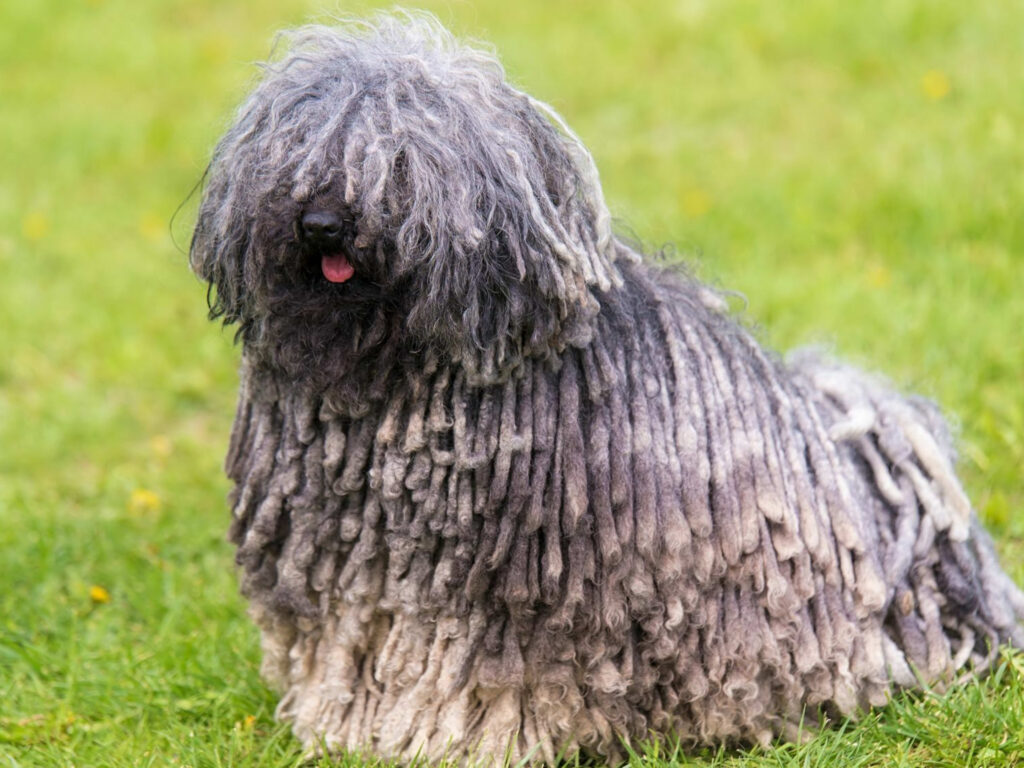Komondor vs. Puli: How to Tell These Corded Canines Apart – Few dogs turn heads quite like the Komondor and the Puli, two Hungarian breeds famous for their dreadlock-like corded coats. At first glance, they might seem like different-sized versions of the same dog—but beneath those striking cords lie two very distinct personalities, histories, and purposes.
Whether you’re a breed enthusiast, a potential owner, or just a curious dog lover, understanding the differences between these two unique breeds is essential. After all, choosing between a gentle giant livestock guardian and a nimble, energetic herding dog is no small decision!
So, how do you tell a Komondor from a Puli—and which one is right for you? Let’s break it down.
1. Physical Appearance: More Than Just the Coat
Komondor


- Massive and muscular, built like a living fortress.
- Pure white cords that can reach the ground, giving them a “mop-like” appearance.
- A broad head with a calm, watchful expression.
Puli
- Compact and agile, with a springy, athletic build.
- Cords that can be black, white, gray, or cream, often shorter and tighter than the Komondor’s.
- Bright, expressive eyes and a lively demeanor.
Key Difference: The Komondor is a powerful guardian, while the Puli is a quick, light-footed herder.
Also Read: Top 7 Duck Hunting Dog Breeds for Hardcore Waterfowl Hunters
2. Size: Big Guardian vs. Small Herder
| Breed | Height (Male) | Weight (Male) | Height (Female) | Weight (Female) |
|---|---|---|---|---|
| Komondor | 27.5+ inches | 100+ lbs | 25.5+ inches | 80+ lbs |
| Puli | 16-17 inches | 25-35 lbs | 14-15 inches | 20-30 lbs |
The Komondor is one of the largest dog breeds, while the Puli is a medium-sized dog—making them vastly different in terms of space and strength requirements.
3. Coat Type & Grooming Needs
Both breeds have corded coats, but maintenance varies:
Komondor
- Cords form naturally but require regular separation to prevent matting.
- Bathing is a big project—their thick cords take hours to dry.
- Minimal shedding, but dirt can get trapped in the cords.
Puli
- Cords are denser and tighter, sometimes requiring manual help to form.
- Easier to bathe due to smaller size, but still high-maintenance.
- Their coat can be kept in shorter cords for easier care.
Grooming Tip: Both breeds need dedicated owners willing to put in the time—or professional groomer help!
4. Origin & Historical Purpose
Komondor
- Ancient livestock guardian bred to protect sheep and goats from wolves and thieves.
- Independent and fearless, designed to work alone in harsh conditions.
Puli
- Herding dog used to drive and control flocks with agility and speed.
- Known for its intelligence and problem-solving skills, often working closely with shepherds.
Fun Fact: The Puli’s signature move is the “Puli jump,” where it leaps over sheep’s backs to direct them!
5. Temperament & Personality
Komondor
- Calm, serious, and protective—a natural guardian.
- Can be aloof with strangers but deeply loyal to family.
- Needs early socialization to prevent overprotectiveness.
Puli


- Energetic, playful, and highly intelligent—always ready for action.
- Bonds strongly with owners and can be clownish and affectionate.
- May develop separation anxiety if left alone too much.
Key Difference: The Komondor is stoic and watchful, while the Puli is bouncy and engaging.
6. Trainability & Energy Levels
Komondor
- Moderate energy—not hyperactive, but needs space to patrol.
- Strong-willed, requiring consistent, firm training.
- Best for experienced dog owners.
Puli
- High energy—thrives on mental and physical challenges.
- Quick learner but can be stubborn; responds best to positive reinforcement.
- Great for active owners who enjoy training and agility.
Also Read: 9 Dog Breeds Known for Their Tough Temperaments
7. Guarding vs. Herding Instincts
- Komondor = Protector (will instinctively guard home & family).
- Puli = Herder (may try to “herd” children or pets by nipping).
Both breeds need proper training to manage these instincts in a home setting.
8. Family & Living Environment Compatibility
Komondor
✔ Best for: Homes with space (large yards, rural settings), experienced owners, families with older kids.
✖ Challenges: Can be territorial; may not suit apartments or first-time owners.
Puli
✔ Best for: Active families, agility/obedience enthusiasts, homes with yards (but can adapt to apartments with enough exercise).
✖ Challenges: Needs constant mental stimulation; may bark if bored.
Final Verdict: Which Breed Is Right for You?
Choose a Komondor if you…
- Want a guardian dog for property or livestock.
- Have experience with large, independent breeds.
- Live in a spacious, preferably rural environment.
Choose a Puli if you…
- Want a smart, energetic companion for agility or herding sports.
- Enjoy training and interactive play.
- Live in a suburban or urban home (with enough exercise).
Not for You If…
- You dislike high-maintenance grooming.
- You prefer a low-energy, easygoing dog.
Conclusion: Two Unique Corded Wonders
While the Komondor and Puli share a striking coat style, they serve very different roles—one as a fearless protector, the other as a nimble herder. Your choice depends on your lifestyle, experience, and living situation.
Whichever you pick, you’ll be gaining a loyal, remarkable companion with centuries of history behind those iconic cords. Just be ready for the grooming commitment—and the endless compliments at the dog park!
